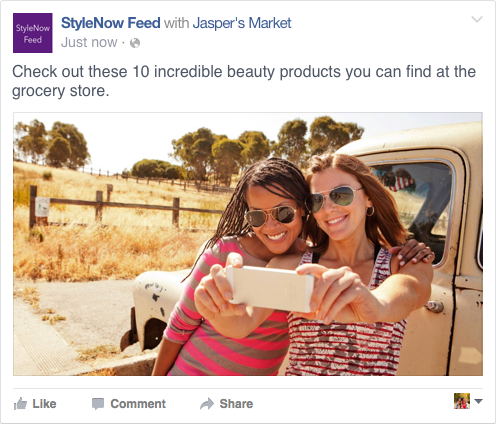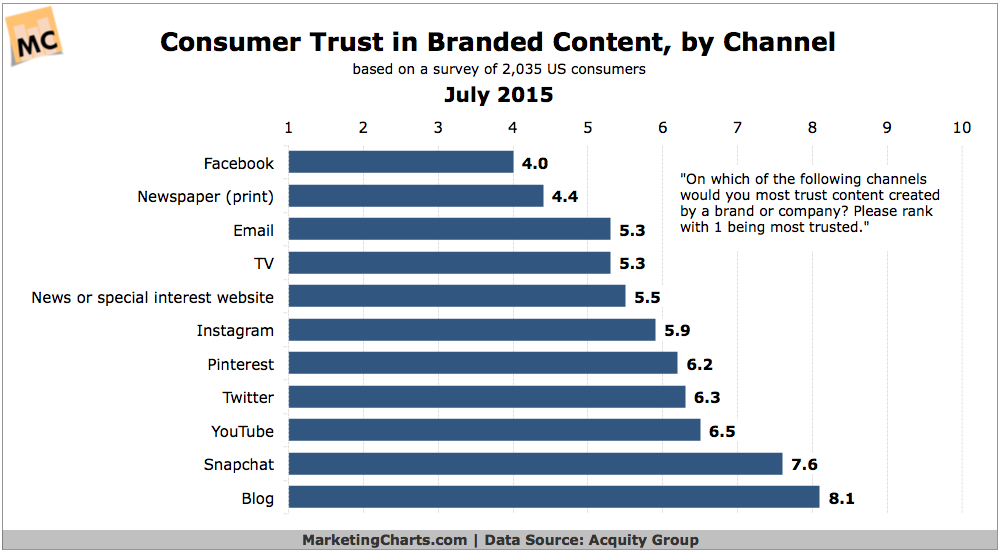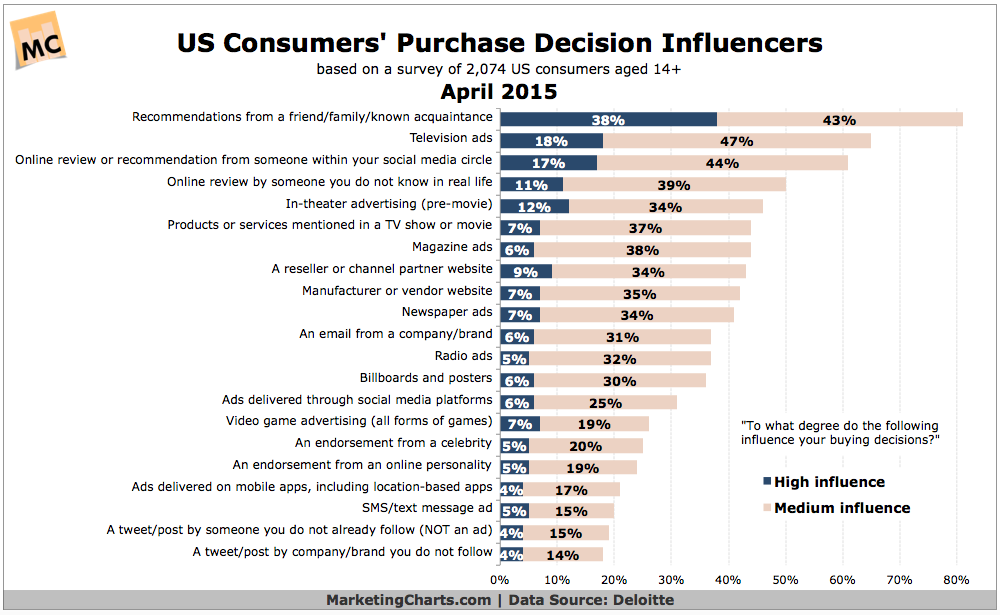You know that when it comes to getting an unbiased, credible, and trustworthy review of a product or service, you're most likely to turn to family and friends. But what about branded content? Are blogs a reliable source of information? Can social media be trusted? Where are people getting their brand information and how much of an influence do different media channels have? Let's take a closer look.
What Is Branded Content?
Previously, the idea of “branded content” was so new and innovative that it didn't really fit into any single category. It's not the same thing as advertising, but it is anything that makes people think about or associate with a brand. Confused yet? Here's a better way to simplify it.
Avi Savar, creative head and founder of Big Fuel, a social media and brand growth firm defines branded content as the difference between “people stories” and “product stories”. He explains, “Traditional advertising is about delivering features, benefits, and a USP through a product story, and then finding creative ways to connect that to people.”
He continues by saying that, “Branded Content is sort of the reverse of this. It's about starting with people stories first, so what are the things that can help brands connect with the hearts and minds of their audience, and then thinking about how you can creatively link that to your product.”
One example of branded content in action is the following video ad from Chipotle. This ad actually won an award for its creativity and was designed to align Chipotle with responsible agricultural practices in the consumer's mind, rather than cheap burritos.
Other well-known examples of branded content include the famous Volvo epic split campaign, which in addition to getting the “Wow!” factor from a wide audience, gets its core audience (truckers) to ask “How can those trucks go in reverse so smoothly like that?” Another is the Dove Real Beauty campaign, where a sketch artist drew images of women based on how they described themselves versus how others saw them.
Although, in the example of Dove, the campaign originally aired in 2013, it's still being viewed today and with nearly 67 million views and over 75,000 users subscribed to Dove's YouTube channel, anyone can easily look at this branded campaign and see how it touched people's emotions.
Branded Content and Media Outlets
Acquity Group looked at which media outlets customers were more inclined to trust when it comes to branded content. As it turns out, some sources have a surprising amount of credibility:
Facebook comes out on top, followed by print newspapers, email and television. Rounding out the bottom are Snapchat and blogs. It's worth noting that according to the study, younger respondents aged from 18-30 were more than twice as likely as baby boomers (aged 52-68) to give Facebook the top rank among branded content.
In case you were wondering, older consumers gave the newspaper their most trusted vote. As for advertising influence, TV and social media alike were near the top, while older Americans found print and direct mail of greater influence.
Who's Doing the Sharing?
Now, before you rush off to create a cavalcade of Facebook ads featuring your company's branded content, you should know that people are far less likely to share a post directly from the company itself. Instead, they're most likely to share a product link when it's recommended by family or friends:
Family, friends and acquaintances hold high sway over consumers' purchasing decisions
What kind of “brand content” Facebook posts are we most willing to share. The all-encompassing “funny video” still gets the most shares, but it's closely followed these days by content that is designed to support a cause or organization.
With branded content, you're essentially borrowing the customer's time and thanking them by making them feel something – laughter, insight, amazement. Although the ads referenced above are designed to make you think, the company behind them is secondary to the story they're sharing.
And if more people become invested in that story, they'll want to tell others, and the cycle continues.
Now you're probably wondering, “branded content sounds great – but how do I make the most of it?”
Content marketers are already struggling to squeeze ROI out of their campaigns in a way that's meaningful to managers and executives alike, so here's how to start making branded content work for you:
Getting Started with Branded Content
First off, Facebook only allows branded content from verified pages – meaning you'll need to have that coveted “blue checkmark” next to your name (or a grey checkmark if you're a business) in order to take advantage of this type of promotion.
The link above describes how to go about verifying your business account on Facebook, or if you're an individual, how to see if you're eligible to be verified.
Once you're verified, you can get started with branded content by going here. Nearly any type of content can be tagged as branded content, including photos, videos, text (with and without links), live videos and more.
How do you know it works? Because you'll see not only the company name being mentioned, but also the key “with” – and then those tagged in the post:

Now, any time the post is shared, those tagged in it will also benefit from the exposure. It's a win-win.
What's The Difference Between Branded Content and @Mentions?
Excellent question! The difference between branded content and your typical @Mention is that the brand which posted the page gets analytical insights that wouldn't ordinarily be available in an @Mention.
It's important to mention here that if you're tagged, you'll still get to see the post's organic and paid engagement, sort by organic versus paid or fans versus non-fans – and otherwise see much of the same data as the owners of the branded content themselves. So although it's not specifically coming from your page, you'll still get to see a lot of the details that a simple mention wouldn't have.
Now, tie this kind of content leverage in with your own UTM parameters and conversion goals and you'll be able to see precisely how well your branded content is performing and converting.
Squeezing Every Drop of Trust and Credibility Out of Branded Content
Let's face it, you're already creating content. Why not take to the channel consumers trust the most and make your content work even harder for you? You'll be getting vastly more exposure when coupled with influencers in your industry and getting people to take action on your content in ways that a typical ad just can't match.
What are your thoughts on using branded content? Has your company used this method effectively to increase trust, brand recognition and awareness among your target audience? Share your thoughts and impressions in the comments below
About the Author: Sherice Jacob helps business owners improve website design and increase conversion rates through compelling copywriting, user-friendly design and smart analytics analysis. Learn more at iElectrify.com and download your free web copy tune-up and conversion checklist today! Follow @sherice on Twitter, LinkedIn or Google+ for more articles like this!


No comments:
Post a Comment